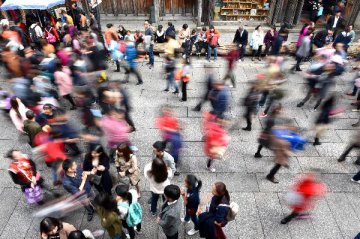
China’s spending spree during the global financial crisis helped pull the world economy out of recession. This time, Beijing’s stimulus might not pack the same punch.
China’s leadership is adopting what some traders dub a “cocktail approach” to arresting its economic slowdown. Its remedies include a mix of greater deficit spending, tax cuts and easier credit.
In a national address in early March, Premier Li Keqiang announced the government will cut taxes and fees for businesses by a total of 2 trillion yuan ($298 billion), or 2% of China’s $13 trillion economy. That includes reductions in value-added taxes—which hit products as they move from raw material to finished goods for sale—and required corporate contributions to pensions.
The scale of the reduction exceeded market expectations. Mr. Li also announced big-ticket spending initiatives, including an investment of 800 billion yuan in railway construction and 1.8 trillion yuan to build roads and waterway transportation.
The tax-cut and spending measures add up to 4.6 trillion yuan to the economy, exceeding the 4-trillion-yuan pro-growth package Beijing rolled out in late 2008. However, China’s economy has become bigger since then, meaning a similar amount of stimulus doesn’t go as far as it used to go. The 4-trillion-yuan package represented 13% of China’s GDP in 2008—and that doesn’t count a massive lending spree that accompanied the spending—and less than 5% now.
“Whether China’s stimulus still has a big impact, or how big an impact it will have for the rest of the world, mostly depends on how large the stimulus is,” says Wang Tao, chief China economist at UBS Group. Relatively speaking, the stimulus then was much bigger, she said.
Another metric of stimulus is the expansion of China’s so-called augmented fiscal deficit, which takes into account the government’s own spending and spending funded by government-controlled financial firms. By that measure, UBS’s study shows that China’s stimulus this time is much smaller than the one launched during the financial crisis. Such deficit spending is expected to increase by as much as 1.8 percentage points in 2019 from last year, compared to a jump of 9.6 percentage points in 2009 from 2008.
Behind the more modest growth push is a realization in Beijing that China’s traditional debt-driven growth model has reached its limit. Mr. Li, the premier, and other senior leaders have time and again sworn off what was known as “flood-irrigation stimulus” in the past.
According to an analysis by Ms. Wang and her team, overall credit growth—including bank loans, corporate bond issuance, local government bond issuance and other debt—will accelerate to 11.5% as of the end of this year from about 9.5% at the end of 2018. By contrast, China’s credit jumped 36% in 2009 after an 18% increase a year earlier.
By 2018, total debt outstanding of companies, central and local governments, and households hit nearly 250% of gross domestic product in 2018, up from less than 150% a decade earlier. Debt growth like that is dangerous, the International Monetary Fund has warned repeatedly. In a January 2018 report, for instance, it noted nearly every case of credit boom similar to China’s was followed by “a major growth slowdown or a financial crisis.”
Total debt of U.S. companies, households, and federal and local governments, by comparison, was 247% of GDP in 2018, with a big spurt in household debt coming in the years before the 2007-09 housing crisis.
Most of China’s debt growth comes from state-owned companies and finance firms controlled by various levels of government, which often use the money to fund projects that are politically appealing but not always commercially viable.
China is getting less output from its borrowing than before. In 2008, according to a report issued last summer by the IMF, 1 trillion yuan of credit was required to generate one trillion yuan of economic output. In 2017, the most recent year for which such data is available, 3.5 trillion yuan of credit was needed for the same scale of GDP creation.
China has improved the efficiency of its credit use in the past three years, thanks to the government’s effort to cut industrial overcapacity and stabilize debt levels. The IMF study shows the 2017 credit-intensity figure was a marked improvement from the levels in the previous two years and predicts more progress in the years ahead.
But to stabilize the country’s overall debt levels, according to the IMF, Beijing will have to speed up revamping its lumbering state sector and carrying out other market-oriented reforms that could lead to more efficient allocation of credit and other resources.
The U.S. is asking China to reform its state sector too, but President Xi Jinping, who sees the state sector as a foundation for party rule, has moved in the other direction, making state companies bigger and strengthening state control over the economy through them.
The constraint from already-high debt levels explains why the nature of Beijing’s pro-growth package is changing from the financial-crisis era—from credit to tax cuts and government spending.
The shift might not be potent as quickly as past efforts: Ms. Wang thinks companies are likely to keep most of the saved taxes rather than spend it, in light of the slowdown and uncertainty caused by the U.S.-China trade tensions.
Source: The Wall Street Journal























Latest comments